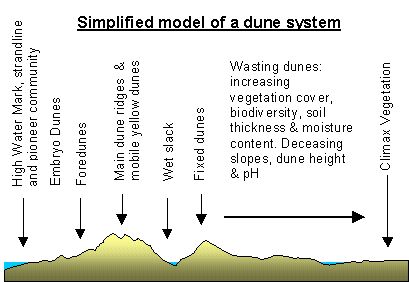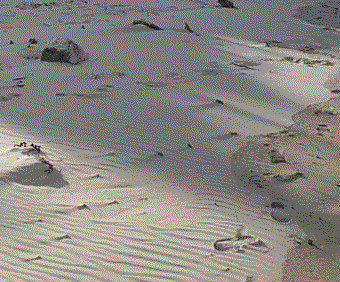|
|
|

The obvious answer would be "next to the sea, just inland from the high water mark." However, they can also occur along the shores of large lakes, e.g. Lake Erie, Canada, and of course in the desert. This website only examines coastal sand dunes. The ideal conditions for the formation of coastal sand dunes include:
|
Large sandy beach exposed at low tide | |
|
Frequent strong winds from the sea | |
|
Macrotidal range, i.e. a big difference between high water and low water levels (over 4 metres) |
Because of this, sand dunes are rare in tropical areas where winds are usually light, and in enclosed seas, e.g. the Mediterranean, where tidal range is small. Sand dunes are most common in coastal regions of the world's temperate belt.
Most sand dune systems appear chaotic at first sight, but on close inspection most have fairly clear topographic and ecological zones. These are well documented in textbooks form the basis for the various models of psammoseres. A psammosere is the succession of vegetation that occurs in sand dunes given a long enough period of time. Most textbook models make the assumption that the age of sand dunes increases with distance inland from the high water mark and show seres (vegetation stages) running from the pioneer community on the strandline (high water mark - HWM) through to the climax vegetation some distance inland.
The diagram shows the common features of a typical sand dune system. If you move the mouse along the base of the dunes from left to right the images on the right will change giving you a visual impression of each part of the system.
 |
 |
Although, every sand dune system is unique, most will include the zones shown on the diagram. The typical features of these zones (as they appear in the British Isles) are described below.
Next to each description is a thumbnail image. Click on it to see it at its full size, then click the back button on the browser to return to the description.
| Slacks are the low areas between the dunes. They have a number of possible origins. Most smaller slacks are excavated by the wind which is funneled between the dune ridges. Slacks are roughly classified as wet or dry, depending on how close to the water table they are. Those at an intermediate stage are referred to as drying. | cross section of wet and dry slacks |
| Larger slacks may be the result of large scale blow outs and the formation of parabolic dune systems. In these cases the slack may well be bounded by dunes which form ridges at right angles to the coast. If you look at the diagram you will begin to understand that the age of dunes does not show a smooth increase with distance from the HWM. Parabolic dunes are commonplace. | |
| Occasionally, some large slacks are actually former areas of the upper foreshore which have been cut off from the sea by the development of dunes further down the beach, e.g. where dunes develop on growing spits or bars. Slacks formed in this way can be referred to as cut-off slacks. Good examples of this can be seen at Holkham Gap (TF890495) in Norfolk, where the process is not yet complete, and at Aberffraw dunes on Anglesey (360685), where it is complete. | |
| In cases like this there is no simple increase in age with distance inland from the HWM, e.g. between A and B the wet slack is actually younger than the dunes which between it and the sea. Between C and D the range of dunes closest to the sea is of the same age as the wet slack. Therefore we would not find an orderly series of seres if we were to carry out a transect. Nor would we expect to see a gradual decline in pH with distance from the sea. | |
| Dry slacks occurring within the main dune
ridge system are usually small in size and consist of bare sand and a few
scattered drought resistant plants, e.g. sea spurge and sea
holly.
Larger dry slacks occur where cut-off slacks have dried out, producing 'links'. Links areas have a much greater cover of low growing vegetation, usually referred to as dune heath. Dune systems and in particular links areas seem to have greater species diversity on the southern and western coasts of Britain where severe frost and snow are rare. Rest Harrow is a typical plant of the dune heath. Not all dune systems have well developed links. Excellent examples can be seen at Aberffraw in Anglesey. |

|
| Wet slacks are usually the most heavily vegetated parts of dune systems, and can show great biodiversity of plant species. pH values are usually lower (i.e. less alkaline) due to the presence of rotting plant litter and the release of humic acid. The organic / nutrient content of the 'soil' is significantly higher than in the dune ridges, encouraging a greater variety of plants. Creeping willow is a typical plant in the milder and wetter southern and western parts of Britain. |  |
| Sea buckthorn is another typical plant, but in many cases it has been introduced by humans to stabilize dune systems. It is a vigorous plant and can quickly dominate the plant community leading to a loss of species diversity. For, this reason, in some 'managed' reserves (e.g. Ainsdale Sand Dunes, Sefton, UK) attempts are made to remove this plant. |  |
| Many rarer species occur in wet slacks,
e.g. marsh helleborine and grass of parnassus.
Especially in western Britain, species diversity is wet slacks is high as
they represent a fairly early stage of the succession. With the
passage of time certain species, e.g. creeping willow, can become
dominant, reducing the diversity.
A word of warning for those of you visit such sites: many of the plants are protected species and picking them can result in a hefty fine and a court appearance! For a more detailed description of the flora of wet slacks see the Ainsdale Case Study. |

|
| Slacks which are further inland are usually older, have thicker soils, lower pH values, higher nutrient content, etc. For this reason, many other plants can occur including plants that are not specifically adapted to sand dune systems, e.g. buttercups, clovers, daisies, etc. |